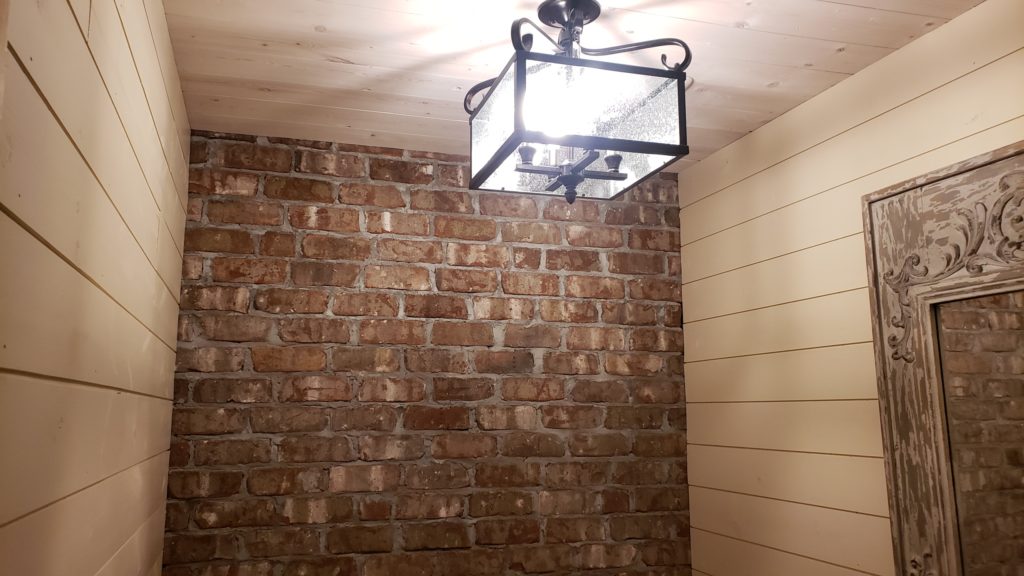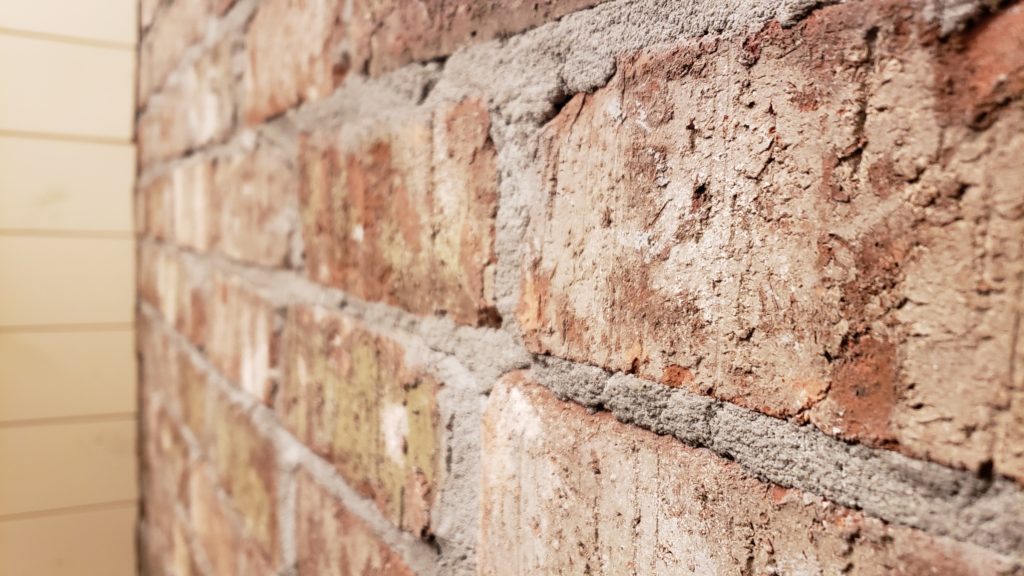
Today I am adding an interior brick accent wall. It’s not structural. It doesn’t have to withstand weather or anything. It’s just an interior brick accent wall. So, this wall is supposed to look like a brick wall that, maybe, used to have plaster on it or something and it got chiseled off and cleaned up for accent. You see that a lot. We’ve done that for a lot for customers in fact. So, now we’re laying this out from scratch in a newer house that’s made to look like an older house. We’ve got to know a few tips to make this look right. We’ve got to understand a little bit of the differences between this type of wall and a pointed exterior brick wall.
Video Version
For the full visual experience, watch the video version here. This video was a live session and the quality wasn’t very good, so I apologize in advance!
What we’re doing here is we’re scraping the joint with a trowel like this. We’re not pointing. If you did an exterior joint, you would need to make sure it’s smooth and sealed. More on that later…
Brick Selection
Since this is supposed to be an interior brick accent wall, the bricks I’ve chosen have a lot of bumps and chips. They kind of look like an old brick that might have been in a wall like this. You can also purchase used brick. They can be a little pricey, because someone has taken the time to clean the mortar of of them, or need lots of clean up work. These reasons are why I chose this brick that is new, but made to look weathered and older.
Let’s Get Started
Next we’re going lay up one of these rows. I’m going to lay the mortar for the bed joint (the horizontal joint under the new course) first. Now, this is not a “how to” on laying brick. I had a couple of uncles that were bricklayers and I got taught a lot of tips from them, but I am no expert bricklayer. So, don’t take all this as the absolute best process for laying bricks. But I know enough to play one on YouTube! 🙂

Let’s just see if we can get this joint in and talk a little bit more about how I’m doing this interior brick accent wall.
On this new course, we’re going to start with a full brick because I started with a half brick on the course below. Now, another thing that you see in these old brick walls, believe me I’ve seen a bunch of them, is you see the end of some bricks coming through that would have tied through to another course in their wall. Those old masonry walls, that we are trying to mimic, were three or four courses thick. Most of the time, 13 to 18 inches thick. Because of that, we’ve got a couple of those ends showing in our rows, too. That makes it look more authentic. Now, we’re going to go with a couple of regular courses next. I ended with a half brick so I’m going to start with a full brick. Then, we’re going to lay up the rest of the course.
The Mortar Joint
I’m going to get a little mortar and butter each joint on the end. After we do our bed joint, we’re still going to butter the end. Now, when we butter the joint, I’m just buttering these two directions because I want to leave this as full on the end as I can. Now, we press that in. We’re going to get good squish out on all three sides that way.
So, we butter that, take the next one and do the same thing. Butter both ways, then squish the brick into the last one. Now, we’re going to just keep repeating. And I’m setting them as I go. Again, this is not a tutorial on how to lay brick. If you were doing a wall, you’d probably lay your corners first and mark your joints on the sides. You would have a story pole here, and you’d mark where every brick course needs to be. At that point, you would lay up the sides of the wall first and set a stringline between and you would need to be right on that stringline. That’s the way you normally lay brick.
The Look of the Interior Brick Accent Wall
This is not the look we’re going for, here. We’re going for sort of a rough look. The brick layer that would have laid these walls up would have just gone through quickly. They would have been up and down. I mean, they wouldn’t have cared about too much irregularity in the courses. A little bit of ins and outs was fine. So, we’re kind of trying to duplicate that whole thing here.
Now, we need a piece of a brick on the edge. You take your brick hammer make a score where you want the brick to break. Do that on all the sides. And now, let’s see if we can get this to break right. It should break right along the scored line. Now, we’re going to lay that brick in the space.
Alright. So now, the difference here on these joints as to in a regular joint is like I’m telling you, you don’t want to run those joints too much with your trowel because it will look too finished. You want the look to be like the mortar was broken and chipped off flat with the plaster. So, now we’re going to take our level (I didn’t mean to indicate that you don’t use a level at all) and I am going to use a level to make sure I don’t get way off, but we’re just not being real fussy about it. So, I’m going to set all the bricks on this course and I’ll tap them down because I don’t want it to be way out. That wouldn’t look right.
Scraping the Brick Joints
Alright. That’s pretty decent there. Now, again, I’m going to show you. What we’re going to do is we’re just going to try to scrape off the excess mortar flush with the face of the brick. If you need to fill a particular area, then do so. Then come back and kind of scrape it which should give you that look that you want.
Alright. That’s about all you want to do. Now, what I’ve been doing is taking a soft bristled brush and I’ve been going over it afterwards. You just kind of knock off the rough spots. Just blend it just a little bit, not a lot. You should wait a few minutes before brushing. I just lay two or three courses, then brush the previous two or three. That give the mortar a few minutes to set up some.
Continue that process and make a cut at the top course, if needed. Here’s a picture of the finished product. I added my ceiling and walls up to the brick, so it would look authentic. That should do it for this project. Now you know one way to add an interior brick accent wall to your home!
For more learning, our monthly checklists and our free eBook on being a more productive DIYer, visit www.AskHandymanBruce.com
I truly hope that these posts help you to make your home a more peaceful and enjoyable place for your family!
Bruce Petrov – https://homemaintenancesolution.com/


Leave a Reply